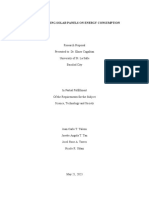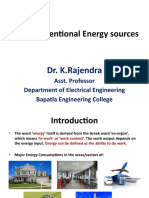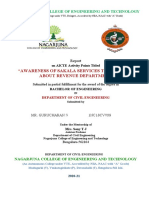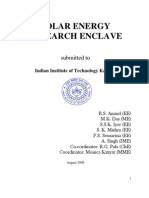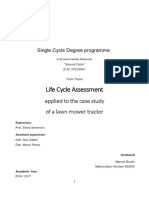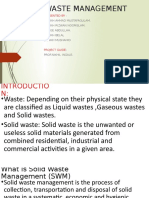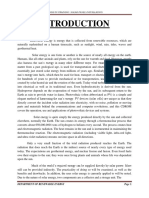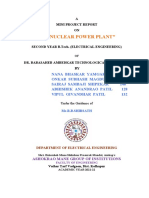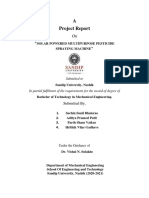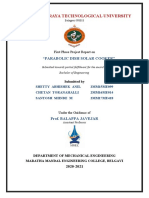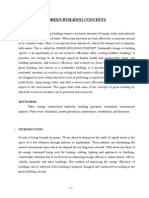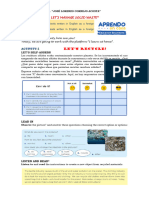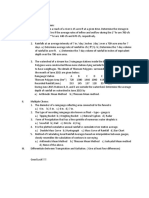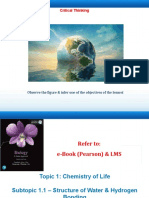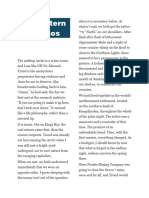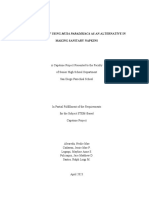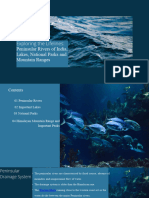TOPIC: SOLAR-POWERED MOBILE WATER PURIFICATION UNITS
1.0 INTRODUCTION
Access to clean drinking water is a fundamental human right, yet millions
of people in Africa still lack this essential resource. Contaminated water
can lead to severe health issues, such as cholera and dysentery, which
disproportionately affect vulnerable populations, particularly children. The
proposed solution is a solar-powered mobile water purification unit
designed to provide safe drinking water to communities in need. This
innovation combines renewable energy with mobility, ensuring that clean
water is accessible even in remote areas.
2.0 ELEMENTS OF INNOVATION
To ensure the success of these purification units, we will focus on five key
elements:
1. Sustainability
2. Mobility
3. Community Involvement
4. Scalability
5. Affordability
Sustainability
Sustainability is at the heart of this innovation. The units will utilize solar
panels to convert sunlight into electricity, powering the water purification
process. This approach has several benefits:
Environmental Impact: Solar energy is renewable and reduces
carbon emissions, making the solution environmentally friendly.
Energy Independence: Communities can operate these units
without relying on external energy sources, which is especially
important in rural areas with limited infrastructure.
pg. 1
� Long-Term Viability: By using sustainable energy, the units can
provide a continuous supply of clean water, contributing to the
community's health and well-being over time.
Mobility
The mobile design of the purification units allows for flexibility in
deployment:
Rapid Response: In disaster situations, such as floods or droughts,
the units can be quickly transported to affected areas to provide
immediate access to clean water.
Access to Remote Areas: Many rural communities in Africa lack
permanent water purification systems. Mobile units can reach these
areas, overcoming logistical challenges related to infrastructure.
Adaptability: The units can be used for various purposes, from
serving individual households to providing clean water for schools,
clinics, or community events.
Community Involvement
Community involvement is crucial for the success and sustainability of the
project:
Training Programs: Local residents will be trained to operate and
maintain the purification units, ensuring that they have the skills
needed to manage the technology effectively.
Ownership and Empowerment: By involving community
members in the project, they will feel a sense of ownership, which
fosters responsibility and encourages the proper use of the units.
Feedback Mechanism: Ongoing communication with the
community will allow for adjustments based on their needs and
experiences, leading to continuous improvement.
Scalability
pg. 2
�The scalability of the purification units ensures they can meet varying
community needs:
Customizable Design: Depending on the size and requirements of
a community, the units can be sized accordingly. Smaller units may
serve individual households, while larger ones can cater to schools
or health facilities.
Phase Expansion: Once the pilot program proves successful in one
community, the model can be replicated in other regions, adjusting
the design and implementation strategies based on local conditions.
Affordability
Affordability is key to making this innovation accessible:
Cost-Effective Materials: By sourcing materials locally and
utilizing simple technologies, the overall cost of the units can be
kept low.
Funding and Partnerships: Collaborations with NGOs,
government agencies, and international organizations can provide
necessary funding and resources, making it easier to subsidize costs
for low-income communities.
Long-Term Savings: By providing a sustainable source of clean
water, the units can reduce healthcare costs associated with
waterborne diseases, ultimately saving communities money in the
long run.
3.0 IMPLEMENTATION STRATEGY
To effectively implement the solar-powered mobile water purification units,
the following strategy will be adopted:
Pilot Program: Start with a pilot project in a targeted community to
test the technology and gather data on its effectiveness. This phase
will help identify challenges and successes before scaling up.
pg. 3
� Partnerships: Establish partnerships with local NGOs and
government bodies to leverage resources, expertise, and credibility.
Engaging with stakeholders will facilitate community buy-in and
support.
Awareness Campaign: Conduct educational campaigns to inform
the community about the importance of clean water and how the
purification unit’s work. Workshops and demonstrations will help
increase acceptance and encourage usage.
Monitoring and Evaluation: Create a monitoring system to assess
the impact of the units on community health, water quality, and
overall satisfaction. Regular evaluations will help refine the program
and ensure it meets community needs.
4.0 CONCLUSION
The solar-powered mobile water purification units present a
transformative solution to the critical issue of access to clean drinking
water in Africa. By focusing on sustainability, mobility, community
involvement, scalability, and affordability, this innovation can empower
communities and improve health outcomes. With careful implementation
and collaboration, this initiative has the potential to significantly impact
the lives of many, fostering a healthier and more productive future.
5.0 Diagrams
(Include diagrams that illustrate the design of the mobile water
purification unit, its components, and the deployment process. Visual aids
can enhance understanding and engagement.
Diagram 1: Design of the Mobile Water Purification Unit
Overview: A labelled diagram showing the components of the unit.
Elements to Include:
o Solar Panels: Indicate where solar panels are located on the
unit.
pg. 4
�o Water Inlet: Show how contaminated water is collected.
o Purification System: Highlight the filtration and purification
processes (e.g., UV purification, activated carbon filters).
o Clean Water Outlet: Illustrate where clean water is
dispensed.
o Storage Tank: Indicate storage for purified water.
pg. 5
�Diagram 2: Deployment Process
Overview: A flowchart illustrating the steps in deploying the
purification units.
Elements to Include:
o Community Assessment: Initial step to identify needs.
o Unit Transportation: Show the movement of units to the
community.
o Installation: Steps for setting up the unit.
o Training Sessions: Indicate community training on operation
and maintenance.
o Monitoring and Feedback: Steps for collecting data on
effectiveness and user feedback.
pg. 6
�pg. 7
�Diagram 3: Community Impact
Overview: A visual representation of the potential benefits to the
community.
Elements to Include:
o Health Improvements: Statistics or icons representing
reduced waterborne diseases.
o Economic Benefits: Illustrate how access to clean water can
lead to increased productivity.
o Community Engagement: Show how community members
are involved in the operation.
o Sustainability: Highlight the environmental benefits of using
solar energy.
pg. 8
�pg. 9
�Diagram 4: Scalability Options
Overview: A chart or infographic showing different sizes and
configurations of the purification units.
Elements to Include:
o Small Unit: For households (specifications and capacity).
o Medium Unit: For schools or small communities.
o Large Unit: For larger community centres or during
emergencies
pg. 10
�pg. 11
�6.0 REFERENCES
NEWater: Specializes in the design and manufacture of solar-powered
water purifiers, portable filtration systems, seawater desalination
equipment, and outdoor water purification devices. Their systems are
designed for various scenarios, including emergency situations, natural
disasters, and remote areas.
World Water & Solar Technologies: Deploys mobile water purifiers
with arrays of solar panels, batteries, and high-pressure pumps. These
units are used in natural-disaster zones, off-grid villages, and military
operations around the world. They offer solutions for contaminated water
supplies and dwindling freshwater reserves.
Green Energy Hub: Discusses the revolutionary idea of using solar
power for water purification. This article explores how solar energy can
address the global water crisis by providing clean drinking water to
remote areas and communities without access to electricity.
pg. 12












